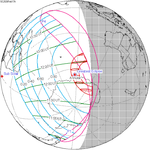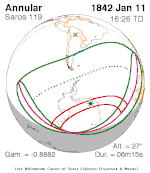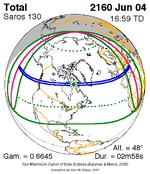Solar eclipse of December 3, 1899
| Solar eclipse of December 3, 1899 | |
|---|---|
| Type of eclipse | |
| Nature | Annular |
| Gamma | −0.9061 |
| Magnitude | 0.9836 |
| Maximum eclipse | |
| Duration | 61 s (1 min 1 s) |
| Coordinates | 86°36′S 121°30′E / 86.6°S 121.5°E |
| Max. width of band | 140 km (87 mi) |
| Times (UTC) | |
| Greatest eclipse | 0:57:28 |
| References | |
| Saros | 121 (54 of 71) |
| Catalog # (SE5000) | 9280 |
An annular solar eclipse occurred at the Moon's ascending node of orbit between Saturday, December 2 and Sunday, December 3, 1899,[1] with a magnitude of 0.9836. A solar eclipse occurs when the Moon passes between Earth and the Sun, thereby totally or partly obscuring the image of the Sun for a viewer on Earth. An annular solar eclipse occurs when the Moon's apparent diameter is smaller than the Sun's, blocking most of the Sun's light and causing the Sun to look like an annulus (ring). An annular eclipse appears as a partial eclipse over a region of the Earth thousands of kilometres wide. Occurring about 4.25 days before perigee (on December 7, 1899, at 6:10 UTC), the Moon's apparent diameter was larger.[2]
The path of annularity was visible from parts of Antarctica. A partial solar eclipse was also visible for parts of southern Australia, New Zealand, and Antarctica.
Description
[edit]The eclipse took place in much of the southeast part of the Indian Ocean and included some of the islands and all of Antarctica (many areas had a 24-hour daylight at the time) except for the South Orkney Islands, it also included most of the south of Western Australia, a part of the southwesternmost state of Victoria and much of Tasmania except for the northeasternmost part, most of New Zealand's South Island, particularly the southern part and a part of the southern portion of the Pacific Ocean. The rim of the eclipse included the area hundreds of miles (or kilometers) from Cocos Islands and the southernmost of South America, it also included the southernmost portion of the Atlantic Ocean.
The umbral portion crossed the middle of Antarctica which was close to the South Pole and the south part of the middle of the continent's peninsula, it lasted over a minute.
The eclipse began at sunrise thousands of miles (or kilometers) offshore from Africa and west of Australia and ended at sunset at Patagonia and thousands of kilometers offshore from Chile and Peru. The greatest eclipse was in the Antarctic Peninsula north of the South Pole at 86.6 S and 121.5 E at 0:57 UTC (8:57 AM local time).[3]
It was around 65% obscured in Antarctica where the Indian and the Pacific Oceans separates.
As the moon moved towards the left on Earth in Australia and New Zealand, at the other side of Northern Antarctica that includes the 70th meridian, it was seen as it was moved towards the bottom right, in areas within the Prime Meridian, it moved right, at the peninsula, it then moved top right as the axis spun at around the 68th parallel south.
Eclipse details
[edit]Shown below are two tables displaying details about this particular solar eclipse. The first table outlines times at which the moon's penumbra or umbra attains the specific parameter, and the second table describes various other parameters pertaining to this eclipse.[4]
| Event | Time (UTC) |
|---|---|
| First Penumbral External Contact | 1899 December 02 at 22:39:46.9 UTC |
| First Umbral External Contact | 1899 December 03 at 00:10:07.9 UTC |
| First Central Line | 1899 December 03 at 00:11:50.2 UTC |
| Greatest Duration | 1899 December 03 at 00:11:50.2 UTC |
| First Umbral Internal Contact | 1899 December 03 at 00:13:35.8 UTC |
| Ecliptic Conjunction | 1899 December 03 at 00:47:39.3 UTC |
| Greatest Eclipse | 1899 December 03 at 00:57:27.6 UTC |
| Equatorial Conjunction | 1899 December 03 at 01:01:47.7 UTC |
| Last Umbral Internal Contact | 1899 December 03 at 01:41:19.0 UTC |
| Last Central Line | 1899 December 03 at 01:43:01.8 UTC |
| Last Umbral External Contact | 1899 December 03 at 01:44:41.3 UTC |
| Last Penumbral External Contact | 1899 December 03 at 03:15:00.7 UTC |
| Parameter | Value |
|---|---|
| Eclipse Magnitude | 0.98358 |
| Eclipse Obscuration | 0.96744 |
| Gamma | −0.90612 |
| Sun Right Ascension | 16h36m20.0s |
| Sun Declination | -22°03'32.4" |
| Sun Semi-Diameter | 16'13.7" |
| Sun Equatorial Horizontal Parallax | 08.9" |
| Moon Right Ascension | 16h36m10.0s |
| Moon Declination | -22°56'05.9" |
| Moon Semi-Diameter | 15'51.6" |
| Moon Equatorial Horizontal Parallax | 0°58'12.6" |
| ΔT | -2.9 s |
Eclipse season
[edit]This eclipse is part of an eclipse season, a period, roughly every six months, when eclipses occur. Only two (or occasionally three) eclipse seasons occur each year, and each season lasts about 35 days and repeats just short of six months (173 days) later; thus two full eclipse seasons always occur each year. Either two or three eclipses happen each eclipse season. In the sequence below, each eclipse is separated by a fortnight.
| December 3 Ascending node (new moon) |
December 17 Descending node (full moon) |
|---|---|
 |
|
| Annular solar eclipse Solar Saros 121 |
Partial lunar eclipse Lunar Saros 133 |
Related eclipses
[edit]Eclipses in 1899
[edit]- A partial solar eclipse on January 11.
- A partial solar eclipse on June 8.
- A total lunar eclipse on June 23.
- An annular solar eclipse on December 3, 1899.
- A partial lunar eclipse on December 17.
Metonic
[edit]- Preceded by: Solar eclipse of February 13, 1896
- Followed by: Solar eclipse of September 21, 1903
Tzolkinex
[edit]- Preceded by: Solar eclipse of October 20, 1892
- Followed by: Solar eclipse of January 14, 1907
Half-Saros
[edit]- Preceded by: Lunar eclipse of November 26, 1890
- Followed by: Lunar eclipse of December 7, 1908
Tritos
[edit]- Preceded by: Solar eclipse of January 1, 1889
- Followed by: Solar eclipse of November 2, 1910
Solar Saros 121
[edit]- Preceded by: Solar eclipse of November 21, 1881
- Followed by: Solar eclipse of December 14, 1917
Inex
[edit]- Preceded by: Solar eclipse of December 22, 1870
- Followed by: Solar eclipse of November 12, 1928
Triad
[edit]- Preceded by: Solar eclipse of February 1, 1813
- Followed by: Solar eclipse of October 3, 1986
Solar eclipses of 1898–1902
[edit]This eclipse is a member of a semester series. An eclipse in a semester series of solar eclipses repeats approximately every 177 days and 4 hours (a semester) at alternating nodes of the Moon's orbit.[5]
The solar eclipses on January 22, 1898 (total) and July 18, 1898 (annular) occur in the previous lunar year eclipse set, and the partial solar eclipse on April 8, 1902 occurs in the next lunar year eclipse set.
| Solar eclipse series sets from 1898 to 1902 | ||||||
|---|---|---|---|---|---|---|
| Ascending node | Descending node | |||||
| Saros | Map | Gamma | Saros | Map | Gamma | |
| 111 | December 13, 1898 Partial |
−1.5252 | 116 | June 8, 1899 Partial |
1.2089 | |
| 121 | December 3, 1899 Annular |
−0.9061 | 126 Totality in Wadesboro, North Carolina |
May 28, 1900 Total |
0.3943 | |
| 131 | November 22, 1900 Annular |
−0.2245 | 136 | May 18, 1901 Total |
−0.3626 | |
| 141 | November 11, 1901 Annular |
0.4758 | 146 | May 7, 1902 Partial |
−1.0831 | |
| 151 | October 31, 1902 Partial |
1.1556 | ||||
Saros 121
[edit]This eclipse is a part of Saros series 121, repeating every 18 years, 11 days, and containing 71 events. The series started with a partial solar eclipse on April 25, 944 AD. It contains total eclipses from July 10, 1070 through October 9, 1809; hybrid eclipses on October 20, 1827 and October 30, 1845; and annular eclipses from November 11, 1863 through February 28, 2044. The series ends at member 71 as a partial eclipse on June 7, 2206. Its eclipses are tabulated in three columns; every third eclipse in the same column is one exeligmos apart, so they all cast shadows over approximately the same parts of the Earth.
The longest duration of totality was produced by member 39 at 6 minutes, 20 seconds on June 21, 1629, and the longest duration of annularity will be produced by member 62 at 2 minutes, 27 seconds on February 28, 2044. All eclipses in this series occur at the Moon’s ascending node of orbit.[6]
| Series members 49–70 occur between 1801 and 2200: | ||
|---|---|---|
| 49 | 50 | 51 |
 October 9, 1809 |
 October 20, 1827 |
 October 30, 1845 |
| 52 | 53 | 54 |
 November 11, 1863 |
 November 21, 1881 |
 December 3, 1899 |
| 55 | 56 | 57 |
 December 14, 1917 |
 December 25, 1935 |
 January 5, 1954 |
| 58 | 59 | 60 |
 January 16, 1972 |
 January 26, 1990 |
 February 7, 2008 |
| 61 | 62 | 63 |
 February 17, 2026 |
 February 28, 2044 |
 March 11, 2062 |
| 64 | 65 | 66 |
 March 21, 2080 |
 April 1, 2098 |
 April 13, 2116 |
| 67 | 68 | 69 |
 April 24, 2134 |
 May 4, 2152 |
 May 16, 2170 |
| 70 | ||
 May 26, 2188 | ||
Metonic series
[edit]The metonic series repeats eclipses every 19 years (6939.69 days), lasting about 5 cycles. Eclipses occur in nearly the same calendar date. In addition, the octon subseries repeats 1/5 of that or every 3.8 years (1387.94 days). All eclipses in this table occur at the Moon's ascending node.
| 22 eclipse events between December 2, 1880 and July 9, 1964 | ||||
|---|---|---|---|---|
| December 2–3 | September 20–21 | July 9–10 | April 26–28 | February 13–14 |
| 111 | 113 | 115 | 117 | 119 |
 December 2, 1880 |
 July 9, 1888 |
 April 26, 1892 |
 February 13, 1896 | |
| 121 | 123 | 125 | 127 | 129 |
 December 3, 1899 |
 September 21, 1903 |
 July 10, 1907 |
 April 28, 1911 |
 February 14, 1915 |
| 131 | 133 | 135 | 137 | 139 |
 December 3, 1918 |
 September 21, 1922 |
 July 9, 1926 |
 April 28, 1930 |
 February 14, 1934 |
| 141 | 143 | 145 | 147 | 149 |
 December 2, 1937 |
 September 21, 1941 |
 July 9, 1945 |
 April 28, 1949 |
 February 14, 1953 |
| 151 | 153 | 155 | ||
 December 2, 1956 |
 September 20, 1960 |
 July 9, 1964 | ||
Tritos series
[edit]This eclipse is a part of a tritos cycle, repeating at alternating nodes every 135 synodic months (≈ 3986.63 days, or 11 years minus 1 month). Their appearance and longitude are irregular due to a lack of synchronization with the anomalistic month (period of perigee), but groupings of 3 tritos cycles (≈ 33 years minus 3 months) come close (≈ 434.044 anomalistic months), so eclipses are similar in these groupings.
| Series members between 1801 and 2200 | ||||
|---|---|---|---|---|
 September 8, 1801 (Saros 112) |
 August 7, 1812 (Saros 113) |
 July 8, 1823 (Saros 114) |
 June 7, 1834 (Saros 115) |
 May 6, 1845 (Saros 116) |
 April 5, 1856 (Saros 117) |
 March 6, 1867 (Saros 118) |
 February 2, 1878 (Saros 119) |
 January 1, 1889 (Saros 120) |
 December 3, 1899 (Saros 121) |
 November 2, 1910 (Saros 122) |
 October 1, 1921 (Saros 123) |
 August 31, 1932 (Saros 124) |
 August 1, 1943 (Saros 125) |
 June 30, 1954 (Saros 126) |
 May 30, 1965 (Saros 127) |
 April 29, 1976 (Saros 128) |
 March 29, 1987 (Saros 129) |
 February 26, 1998 (Saros 130) |
 January 26, 2009 (Saros 131) |
 December 26, 2019 (Saros 132) |
 November 25, 2030 (Saros 133) |
 October 25, 2041 (Saros 134) |
 September 22, 2052 (Saros 135) |
 August 24, 2063 (Saros 136) |
 July 24, 2074 (Saros 137) |
 June 22, 2085 (Saros 138) |
 May 22, 2096 (Saros 139) |
 April 23, 2107 (Saros 140) |
 March 22, 2118 (Saros 141) |
 February 18, 2129 (Saros 142) |
 January 20, 2140 (Saros 143) |
 December 19, 2150 (Saros 144) |
 November 17, 2161 (Saros 145) |
 October 17, 2172 (Saros 146) |
 September 16, 2183 (Saros 147) |
 August 16, 2194 (Saros 148) | |||
Inex series
[edit]This eclipse is a part of the long period inex cycle, repeating at alternating nodes, every 358 synodic months (≈ 10,571.95 days, or 29 years minus 20 days). Their appearance and longitude are irregular due to a lack of synchronization with the anomalistic month (period of perigee). However, groupings of 3 inex cycles (≈ 87 years minus 2 months) comes close (≈ 1,151.02 anomalistic months), so eclipses are similar in these groupings.
| Series members between 1801 and 2200 | ||
|---|---|---|
 February 1, 1813 (Saros 118) |
 January 11, 1842 (Saros 119) |
 December 22, 1870 (Saros 120) |
 December 3, 1899 (Saros 121) |
 November 12, 1928 (Saros 122) |
 October 23, 1957 (Saros 123) |
 October 3, 1986 (Saros 124) |
 September 13, 2015 (Saros 125) |
 August 23, 2044 (Saros 126) |
 August 3, 2073 (Saros 127) |
 July 15, 2102 (Saros 128) |
 June 25, 2131 (Saros 129) |
 June 4, 2160 (Saros 130) |
 May 15, 2189 (Saros 131) |
|
See also
[edit]References
[edit]- ^ "Eclipses of Sun and Moon". The Philadelphia Inquirer. Philadelphia, Pennsylvania. 1899-12-03. p. 11. Retrieved 2023-10-27 – via Newspapers.com.
- ^ "Moon Distances for London, United Kingdom, England". timeanddate. Retrieved 26 August 2024.
- ^ "Solar eclipse of November 21, 1881". NASA. Retrieved March 24, 2017.
- ^ "Annular Solar Eclipse of 1899 Dec 03". EclipseWise.com. Retrieved 26 August 2024.
- ^ van Gent, R.H. "Solar- and Lunar-Eclipse Predictions from Antiquity to the Present". A Catalogue of Eclipse Cycles. Utrecht University. Retrieved 6 October 2018.
- ^ "NASA - Catalog of Solar Eclipses of Saros 121". eclipse.gsfc.nasa.gov.




